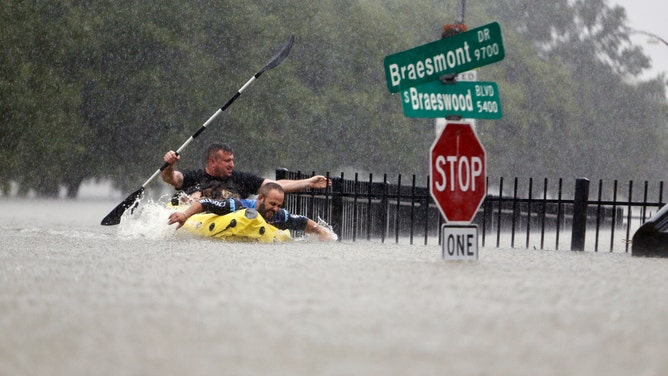FEMA making ‘substantive change’ to National Flood Insurance Program to account for climate change
Changes to the NFIP will also cause some home values to change, as home values are determined by a number of factors such as the cost to insure a home.

FILE - In this Sunday, Aug. 27, 2017. file photo, two kayakers try to beat the current pushing them down an overflowing Brays Bayou from Tropical Storm Harvey in Houston, Texas. The Intergovernmental Panel on Climate Change report released on Monday, Aug. 9, 2021, says warming already is smacking Earth hard and quickly with accelerating sea level rise, shrinking ice and worsening extremes such as heat waves, droughts, floods and storms. (Mark Mulligan/Houston Chronicle via AP, File)
On Oct. 1, the Federal Emergency Management Agency will begin implementing ‘the most substantive change’ to the National Flood Insurance Program (NFIP) in over 50 years, according to David Maurstad, Senior Executive of NFIP.
Out with the old, in with the new
The current approach for the NFIP factors in a property’s elevation and if it has a 1% chance of flooding annually.
The new approach beginning this fall will consider additional factors, such as the type of flood risk involved (e.g. coastal or river flooding, rainfall), the property’s proximity to the source of potential flooding, and the cost to replace or rebuild a home.
Another new consideration under the new model that is the most key: factors potentially brought about by climate change. Examples of these may include drought, rising sea levels and wildfires.
In a statement, Maurstad said, "FEMA is building on years of investment in flood hazard information by incorporating private sector data sets, catastrophe models and evolving actuarial science."
How this impacts homeowners
Because of these changes, some homeowners might see their premiums increase, whereas others may see theirs decrease. Overall, most homeowners will see the average annual increase of 10%.
For example, about 89 percent of federal flood insurance holders in Harris County, Texas will have their insurance rates increase by up to $60 per month, according to FEMA. On the flipside, about 11 percent of federal flood insurance holders will see their rates drop by up to $100 per month.
Changes to the NFIP will also cause some home values to change, as home values are determined by a number of factors such as the cost to insure a home.
Maurstad said, "It’s just important that we address that inequity that the lower-value homes shouldn’t be subsidizing the higher-value homes going forward."